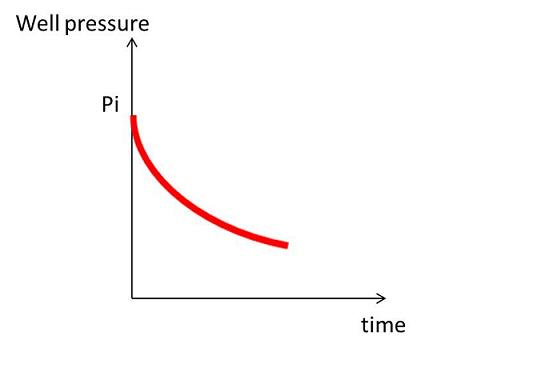

# load well-test dataĭf = pd.read_csv('/content/pyreservoir/data/welltest/welltest1_constant_rate_drawdown.csv') We first load the first dataset, that contains the time and flowing pressure (BHFP) columns. In the first part, we will analyze a well-test result from a constant rate drawdown test. The following figure represents the stimulus given to the well (top row) and the response obtained from the well (bottom row).Īll parts are using the same reservoir and fluid properties defined above. Each part uses the dataset that is started by filename " welltest1" for test 1, " welltest2" for test 2, and " welltest3" for test 3. There are three tests in this tutorial the constant rate drawdown, the multiple rate drawdown, and the constant pressure test. Pi = 2500 # Initial reservoir pressure, psia The initial reservoir pressure is 2,500 psia. Then, let us input all the required reservoir and fluid properties for our analysis. The Matplotlib style that we use now is Seaborn (can be others, depends on your preference).
#DRAWDOWN TEST FULL#
> Get here for the full Python script of the tutorial <<<įirst, our usual routine is to import all three libraries ( Numpy, Matplotlib, and Pandas), and also the wellanalysis library that we use. The datasets are inside a folder and you could get here. Also, we will use six datasets, each for each part in the following tutorials.
#DRAWDOWN TEST DOWNLOAD#
In this tutorial, we will use a program called " wellanalysis" that you could download from the hyperlink shown.
#DRAWDOWN TEST SKIN#
The following table lists the plot components of each well-test and the formula to calculate some reservoir variables, namely the permeability ( k), or permeability-thickness product, ( kh), skin factor ( s), reservoir size ( re), and pore volume ( PV). In a constant pressure well-test analysis, a specified plot is devised. Using this principle, we consider the rates as a sum of the preceding rate series. In a multiple rate drawdown test, we apply the Superposition Principle (that we have already discussed in our previous article) on our analysis. The LTR is also often analyzed to give information on the reservoir size (radius). For analysis, a l inear regression done on the MTR curve gives lots of information reservoir permeability and skin factor. However, mostly this device is not installed, therefore the ETR exists, shown here the deviation of the red curve. Therefore, in the recorded pressure, the curve will look like the blue curve ( ideal curve) and there is no ETR. Often in some cases, the well is installed with a downhole shut-in device to minimize the wellbore storage effect. The three time-regimes are recognized from the curvature of the pressure semilog curve. We have intensively discussed these flow behavior in our previous article about well-transient modeling. The LTR is the time period is finite-acting (or pseudosteady-state) flow is affected by reservoir boundary. The MTR is the time period when the well is infinite-acting (or steady-state) flow still does not reach the reservoir boundary. The ETR is the time period when flow in the well experiences wellbore storage effect after the flow is stopped, the fluid from the reservoir can still flow inside the well at a decreasing rate. If we plot the data in a semilog curve (like below), we could identify three time-regimes the early time-regime (ETR), the middle time-regime (MTR), and the long time-regime (LTR). In the drawdown test, where the well flows, the recorded flowing pressure decreases with time (also known as the normal time). The figure below is an interpretation of a constant rate drawdown test. This is known as a multiple rate drawdown test.īoth ways of drawdown tests have the same basic concept of analysis and interpretation. In addition, the drawdown test can also be done by flowing the well under step-like changing of rates over some time, for instance, flowing 1,000 STB/D in the first 24 hours, then increase to 1,500 STB/D in the next 24 hours. This is known as a constant rate drawdown test. The basic way of doing a drawdown test is flowing the well under a constant rate over a long period of time, for instance, flowing 1,000 barrels a day in 48 hours. Analysis of Drawdown and Constant Pressure Test The objective of conducting a well-test analysis is not to produce economic fluid from the reservoir but to test the reservoir for an understanding of some properties and conditions, namely reservoir permeability, skin factor (the level of damage of the formation around the well), and reservoir extent or size.


 0 kommentar(er)
0 kommentar(er)
